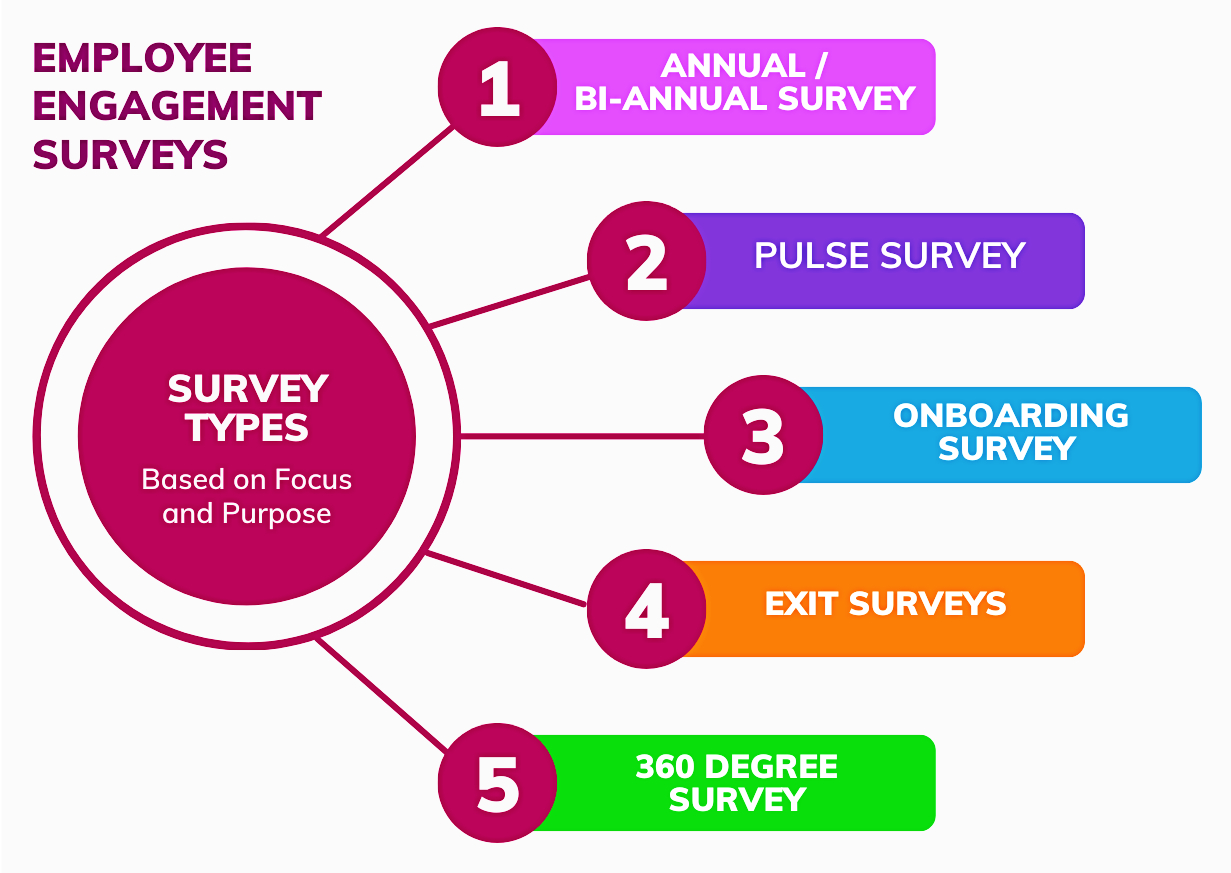22 Employee Engagement Surveys to Attract and Retain Talent
Date: 06-Jan-2024

Focusing on employee engagement is crucial for organizations because it directly impacts productivity, retention, and overall success. Engaged employees are more motivated, committed, and enthusiastic about their work. They tend to be more innovative, collaborate better with colleagues, and contribute positively to the company culture. Additionally, higher engagement often leads to lower turnover rates, reducing recruitment costs and preserving institutional knowledge within the organization. Ultimately, a focus on employee engagement creates a more dynamic, resilient, and thriving workplace.

As per SHRM India and BI Worldwide’s Engagement Survey report, It was highlighted that organizations with effective employee engagement programs in India experienced 2.5 times more revenue growth compared to organizations with lower engagement levels.
Read about 2023, Employee engagement trends, and statistics from here
Surveys are a popular method to measure employee engagement for several reasons:
Surveys provide quantitative data that can be analyzed and compared over time. This helps in tracking trends, identifying patterns, and measuring changes in engagement levels within an organization.
Many surveys use standardized metrics and questions, allowing for benchmarking against industry standards or comparing results with other companies in the same sector. This helps in understanding where an organization stands in relation to others.
Surveys often allow for anonymous responses, encouraging employees to provide honest feedback without fear of repercussions. This anonymity fosters candid responses, leading to more accurate insights into the actual sentiments of the workforce.
Surveys can pinpoint specific areas where engagement might be lacking. Whether it’s communication, leadership, work-life balance, or other factors, surveys help in identifying these pain points.
The feedback obtained from surveys can be used to create actionable insights. It helps leadership and HR teams understand the needs and concerns of employees, enabling them to develop strategies to enhance engagement and address any issues.
Involving employees through surveys can make them feel heard and valued. When organizations act upon the feedback received, it enhances trust and shows employees that their opinions matter.
Surveys are not one-time assessments; they can be conducted regularly to track changes and improvements in engagement levels. This allows organizations to make continuous efforts to enhance the employee experience.
Overall, surveys serve as a structured and effective tool for organizations to assess, understand, and improve employee engagement, ultimately contributing to a more positive and productive work environment.
Employee engagement surveys come in various forms, each with its own focus and purpose. Here are some common types:
These comprehensive surveys typically cover a wide range of engagement factors, including job satisfaction, organizational culture, leadership effectiveness, and overall employee experience. They provide a holistic view of engagement levels within the organization.
Short and frequent surveys are conducted more frequently than annual surveys. These are quick check-ins that focus on specific aspects of the workplace, often addressing immediate concerns or tracking changes in sentiment over shorter periods.
These surveys gauge the experience of new employees during their onboarding process. They aim to understand how well the company integrates new hires, their initial impressions, and whether expectations align with reality.
Conducted when employees leave the organization, these surveys gather feedback about the reasons for departure, their overall experience, and insights into areas that might need improvement.
Targeted surveys focusing on the engagement levels within specific departments or teams. These surveys provide more granular insights and help tailor engagement strategies to meet the unique needs of different units within the organization.
Assess how well employees align with the company’s values, mission, and vision. They measure whether employees understand and resonate with the organization’s culture.
Focus on employees’ well-being, stress levels, and satisfaction with work-life balance. These surveys help identify areas where the organization can support employee health and mental well-being.
It is often referred to as a “360 survey,” a comprehensive assessment tool that gathers feedback from multiple sources about an individual’s performance. Unlike traditional performance reviews that involve feedback from just a manager, a 360-degree survey collects input from various perspectives surrounding an individual, including:
The survey typically asks respondents to rate the individual’s skills, competencies, behavior, and performance against predefined criteria. The feedback focuses on strengths, weaknesses, areas for improvement, and overall effectiveness in various aspects of their role.
The anonymity of responses encourages honest and constructive feedback, providing a more comprehensive view of an individual’s strengths and areas for development. The goal is to offer a well-rounded assessment that helps individuals understand how they are perceived by those they interact with within the workplace.
Each type of survey serves a specific purpose, allowing organizations to gather targeted insights into different aspects of employee engagement. Combining various survey types can provide a comprehensive understanding of the overall employee experience and help in formulating effective engagement strategies.
These questions can serve as a starting point for an employee engagement survey, but it’s essential to tailor them to fit the specific context, culture, and objectives of your organization. Additionally, open-ended questions can be included to allow employees to provide more detailed feedback and insights.
ENGAGEMENT DRIVE PERFORMANCE